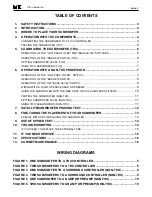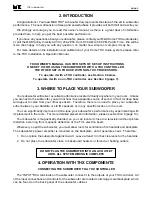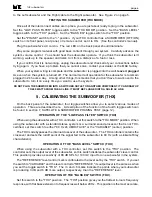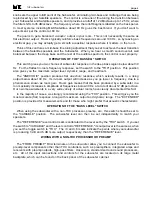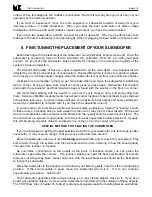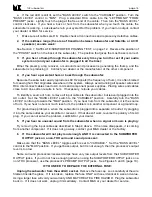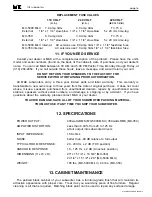
THX subwoofers
page 11
to feed these filters.
To connect one of these filters, run one set of shielded RCA - RCA interconnect cables from the
receiver, amp or preamp's MAIN OUTPUT to the input jacks on the HP-80 or VF-80. Run another set
of interconnects from the high frequency output jacks on the filter to receiver or amp's POWER AMP
inputs. Last, run interconnects from the subwoofer output jacks to the subwoofer's "INPUT" jacks.
See the instructions enclosed with your filter for wiring diagrams.
When using these filters,set the "BASS LEVEL" switch to "VARIABLE" and the "LOW PASS
FILTER" switch to "80 Hz 24 dB/OCTAVE."
TESTING THE SUBWOOFER (NON-THX)
Once all of the interconnect cables are in place, you are ready to plug in your subwoofer. Make
sure the "LOW PASS FILTER" switch is set to the "80 Hz 24 dB/OCTAVE" position and the "BASS
LEVEL" control to set to "VARIABLE". Make sure the "PHASE" switch is set to the "+" position. Then
plug the AC cord in. The red LED on the back panel of the subwoofer should illuminate.
When your system wiring is complete and the subwoofer is plugged into the wall, leave it plugged
in, even when the system is turned off. The normal mode of operation for the subwoofer is to remain
plugged in 24 hours a day. Among other things, this means that you don't have to walk over to the
subwoofer to turn it on every time you want to use the system.
DO NOT PLUG THE SUBWOOFER INTO A SWITCHED OUTLET ON ANOTHER
COMPONENT. THE SUBWOOFER CAN DRAW UP TO 700 WATTS FROM THE
AC LINE. IT MUST BE PLUGGED INTO A SOLID AC LINE.
Now, play some music through your system to make sure that the Satellite speakers are working
properly. If they are, carefully advance the "BASS LEVEL" control. The subwoofer should begin to
play. Set the "BASS LEVEL" control where the subwoofer sounds in balance with the Satellite
speakers. If the system is not working properly, unplug the subwoofer and check all of your
connections. Call your dealer or the factory if you cannot solve any problem.
SETTING THE SUBWOOFER LEVEL (NON-THX)
Here are two ways to set the subwoofer level. First, if you can obtain a spectrum analyzer, you can
accurately match the subwoofer to the main speakers by feeding a wideband pink noise signal into
the full system (both the satellites and the subwoofer). Set up the analyzer at the main listening
position. Adjust the "BASS LEVEL" control until the analyzer display shows the flattest response
through the 70 to 125 Hz midbass region.
If you don't have access to an analyzer, the best way to match the level of the subwoofer to your
system is to do it by ear, listening over several hours to familiar recordings. Make adjustments to the
level in small increments, depending on whether the bass level sounds too high or too low.
There is a possibility that your surround sound processor has a built in test generator for the
subwoofer level, but most non-THX processors do not. If you do have such a surround sound
processor, see SETTING SUBWOOFER LEVEL (THX), on page 7.
In any case, remember that you can always deliberately set the level higher if you want more bass
or lower if you don't want to disturb your neighbors or family.
USING TWO SUBWOOFERS (NON-THX)
Using two subwoofers in your audio/video system will give you the ultimate in bass performance.
It will give you improved impact and definition, as well as greater output and dynamic range. If you
locate the subwoofers in different parts of the room, you will hear a better overall frequency response,
as the room modes excited by one woofer are complemented by the presence of the other.
Alternately, if you stack two subwoofers, one on top of the other, their outputs will couple and give you


